When I was nine years old, my Uncle Joe and Aunt Doris gave me a fly tying kit for Christmas. It was boxed and wrapped and tied off with a big shiny red ribbon, and I opened it at the Tanner family Christmas party, which, if memory serves, was held the weekend before the actual holiday. This particular celebration was at Joe’s home (we rotated every Christmas; one year at our house, the next year at Uncle Jim’s, the next at Uncle Austin’s, and so on) and I don’t think I was ever so excited as when I pulled off that wrapping paper and saw the treasure I’d just received.
After all, I was about as serious a nine year old angler as it was possible to be, spending every spare minute sneaking along the brook that ran next to my folk’s house or casting from the grassy banks of the pond over at Murrow Park, and I’d heard just enough about fly fishing (I was a worm kid back then) to know that it was special. You could fish most things with a spinning rod — night-crawlers, of course, and minnows, and salmon eggs, and even the varied and assorted lures that old Larry Paugh stacked on his shelves at the Sport Shop — but not flies. Flies were different. You needed both a fly rod and a specialized fly line to use them, and the trout that ate flies — excuse me, the trout that took flies — were nicer than the ones my friends and I caught on bait; prettier and more sophisticated and much, much larger.
And now, with the blessing of my Uncle Joe (who had an awe-inspiring six pound rainbow mounted on his wall and who was obviously a fine judge of overall fishing potential) I was about to join the club; that very elite, very wonderful group of elegant and genteel individuals who fished with a fly rod. Better yet, I was going to learn to tie my own flies; subtle, lifelike creations that would tempt the various & sundry Moby Dicks that lived nearby in ways that a sodden gob of night-crawlers surely never could. Life, as seen through the eyes of a nine year old boy at Christmas time, was just about perfect.
I’m sorry to report that as much as I hoped to prolong it indefinitely, “just about perfect” only lasted for a single day. When I opened my gift the following afternoon, the instructions were printed in something akin to ancient Gaelic, and I was overwhelmed by the sheer complexity of the entire fly tying process.
To tell the truth, I’m not quite sure what I expected; maybe flies were like Chia Pets and you grew them with water and sunshine, or maybe they came packaged like stamps in shiny green books and you had to cut out the pieces and then paste them back together. In any case, I’d never seen an actual fly before so I didn’t have any understanding of how complicated they were, or even what they were supposed to look like. In the end, I did the only thing a nine year old boy whose father didn’t fish (in retrospect, my dad’s only significant failing as a human being) could reasonably manage. I rummaged around in the box, pulling out hooks and tinsel and chenille, looking everything over with a keen, if confused, eye and then, after attempting to translate the instructions into English a few more times, I put it all away and stuffed it in my closet, never to be seen again.
Which just goes to show that at the tender age of nine, I was not quite ready to become a fly fisherman, much less a genteel fly tyer.
Now, however, with the additional 50 years on top of that previous nine, I’ve learned to appreciate a beautiful and well-tied fly; even if, as my friends persist in saying, I am patently unable to tie them myself. Which doesn’t mean that I can’t tie my own flies. I can, and do. Still, there’s a world of difference between the utilitarian patterns that emanate from my vise and the delicate, artistic beauties that the real masters spin out.
And, of course, these days everybody’s a damn critic.
In my mind, there are only two true schools of fly tying. The first I’ve named the Utilitarian School, after my own efforts. Utilitarian School flies are tied to catch fish and last a long time. Period. No arses, no elbows, no delicate plumage or hackles or antennae that can consume long minutes at the vise or be chewed off in a split second by the first toothy brown trout that comes swimming along. Nope, utilitarian flies are the ultimate in economical dependability. Zelon shucks instead of fiber tails, deer hair wings instead of mallard or wood duck, no protruding hackles unless absolutely, positively necessary.
For those of you who insist on getting something of value from a piece like this, pay special attention for the next eight seconds. A sparkle dun and an X-caddis, a clear wing spinner, a bead head caddis pupa with a synthetic green or gray body, a Last Chance Cripple, a black rabbit strip leech.
That’s all you’ll ever need for trout. Unless, of course, it turns out that you need something different. We are talking about fishing, after all.
I don’t have a title for the other school of fly tying, although it’s certainly more all-encompassing. I guess we could call it the Purist’s School, or the Enthusiast’s School, or even the Artist’s School. Perhaps the name itself is less important than the actual description. In essence, the flies in this category are tied with a dual purpose. On one hand, they’re supposed to reflect the tyer’s flair, creativity and style, while on the other they’re also meant to catch a few fish. The latter being the true key — a fly that won’t catch fish may be beautiful, it may be intricate, it may, in fact, even be representative of the true art of fly tying, but it’s still no more useful than teats on a bull.
I learned to tie flies — I was in my twenties at the time — from my friend Steve Quackenbush. Steve taught me, perhaps without realizing it himself, that a tyer’s style results in large part from the way he fishes. Steve didn’t get out on the river all that much, but when he did he fished conservatively, making short casts to rising trout on open, shallow flats. As a consequence, he very rarely lost his flies, and it made sense that he would rather tie two or three perfect Quill Goldens than a dozen half-assed “Frankenstein” Goldens.
A quick sidebar. Steve, who was not really comfortable wading deep to begin with, stayed in the shallows after he was smashed into from behind by a fat man in a canoe. He damn near drowned, or at least it looked that way to me from across the river, and afterwards he steered clear of anything deeper than his knees.
I, on the other hand, was the kind of fisherman infatuated with making seventy foot casts to dimpling trout under overhanging limbs on the far side of the pool. As you may imagine, I lost a lot of flies — a lot of flies — and I eventually got into tying to save money. Since I was fishing more than two hundred evenings a year, and since it cost me a buck every time I left a Hendrickson or Hemingway Caddis in the branches on the other side of the river, I really had no choice. It was either learn to tie my own flies or take up a cheaper sport, like yachting.
As you’ve probably already guessed, my motivations being what they were, I didn’t tie my flies to the same exacting standards that Steve embraced. His flies were both pretty and functional. Mine were pretty functional. Still, I learned the important things — proportion and balance being the two biggies, though the Catskill style of split, upright wings, Marinaro’s split tails, hackling, whip-finishing, thread management and a dozen other little tricks also came in handy.
In the end, perhaps the most useful thing (of any number of useful things) that I gleaned from Steve’s patient instruction was an understanding of what a really well-tied fly looked like. And that’s something every fly fisher, whether or not he (or she) ties his own flies, should be aware of. Because in a strange sort of way, flies are like fruit. When you’re sorting through the bins at the grocery store, you’re looking for something sweet and juicy and ripe. At the same time, you want to avoid wasting your money on something bruised and rotten.
There are so many good tyers these days, tying so many beautiful flies, that it’s literally mind boggling. Not that there aren’t just as many bad tyers as there used to be, churning out dozens of patterns — dries, nymphs, wet and streamers — that look suspiciously like hair brushes or shaggy, oversized Griffith’s Gnats. There are. But the good tyers are the news.
Let’s start at the pinnacle, although I need to issue a disclaimer first. I mentioned earlier that in order to be up for consideration, a fly has to be designed to catch fish. Well, despite their sculpted, artistic appearance, salmon flies (the flies tied to catch Atlantic salmon, not the flies tied to represent the huge, orange-bodied western stonefly, Pteronarcys California) were developed in Europe to tempt fish swimming upstream to spawn; fish that, due to the nature of their life cycle, were passing through or resting but not actively feeding.

Because of their form and color and delicacy, as well as the level of skill required to craft them and the rarity of their materials — do you have any bustard or polar bear fur in your tying kit? — salmon flies have become a favorite choice for the most creative tyers. In fact, the very finest examples of the genre are framed and displayed as works of art, and a fly, one single fly, might cost hundreds of dollars or more. That doesn’t mean that they aren’t “real” flies, though. Most, if not all, salmon flies still exist as workable, fishable patterns, at least if you can find someone who’s willing to tie them for you.
Indeed, Paul Rossman, who’s the most accomplished salmon fly tyer I know, routinely does things with feathers that are not only awe-inspiring but, as far as I can tell from my years laboring at the vise, simply impossible. Think of a magical creature out of Greek mythology — a combination of peacock and rainbow and golden-scaled mermaid — and you have a pretty good idea of the beauty that Paul creates by melding feathers to a hook.
Compared to salmon flies, even the finest trout flies are a bit pedestrian, but that doesn’t mean they aren’t intricate or beautiful or cunning in their own right. A lightly hackled Quill Gordon, a Royal Wulff, a Harrop Captive Dun, even the ubiquitous Parachute Adams; all these flies are classics, and not only because of their pedigrees. Each of them, and a hundred others cut from the same cloth, endure because they do two different things exceedingly well.
First, of course, they are fine examples of the tyer’s art. They marry material and technique in a way that creates the illusion of life, as well as the proper silhouette and color for the particular insect they’re meant to mimic (or in the case of attractor patterns, the general type of creature that they’re supposed to represent).
Second, and in my opinion this is more important, they are problem solvers, the keys to puzzles, the answers to the question of how to catch trout, even large, difficult trout, in very specific situations.
Show me a well-designed fly, and I’ll show you a tyer who’s not only looked at the insect in question, but who’s also considered how his creation will interact with the fish’s environment. The tyers who can do this on a consistent basis — René Harrop, Craig Mathews and John Juracek come to mind — not only possess the genius of inspiration, they are also gifted with a unique ability to observe the natural world. In other words, they can look at a single mayfly or a lone caddis and see how it relates to its surroundings at the same time they’re examining the details of its anatomy. That’s an unusual skill, but one that comes in awfully handy if you love fishing for trout and tying your own flies.
When I head to the river, I typically have a minimum of four or five hundred individual flies stashed in my sling pack. Most of them are usable to one extent or another, having evolved at my vise from an assortment of tying materials into dries, nymphs, streamers, and even a few soft-hackled wets. At any one time, a couple dozen are likely to be new, just off the vise, geared toward a particular situation that I’ve been anticipating, while maybe a hundred more are old, ragged, nasty things that I’ve convinced myself have a few more casts left in them. You might be surprised, but some of the nastiest ones are my true favorites, especially if they’ve been chewed almost beyond recognition.
In fact, old flies are a little bit like old bird dogs. They’re not as pretty as they used to be and their best days are probably behind them, but just looking at them brings back the memories we cherish and they hold enough promise for the future that we can’t bear to retire them quite yet.
The vast majority of my stockpile is typically in the “tweener” stage, not quite mint but not so beat up as to warrant much concern. Most of them have caught some fish, and it’s pretty reasonable to assume that, barring some cataclysmic change in my life, they’re going to catch some more. I don’t know about you, but I find that kind of thought comforting.
I also have a few special flies, gifts usually, that I’ve managed to hang on to over the years. Michel Fontan, the noted French chef and fisherman, gave me a couple of his framed salmon flies for a wedding present; I also have a bunch of René Harrop’s creations, and a Paul Rossman salmon fly, and one lone emerger that Charles Jardine, the British author, handed me on the Henry’s Fork back in 1994. And I have a couple of my brother-in-law Pat’s flies, which are special for a whole host of reasons, not the least of which is his skill as a tyer.
Pat ties all kinds of flies, but my favorites (and probably his) are what the old timers used to call minutiae, though with a twist. Most little flies — for the sake of clarity, let’s say size 20 and smaller — are pretty simple. They have to be; there’s just not much space on a size 20 hook for a bunch of material. Pat, however, has figured out how to tie perfect, fishable size 28 Royal Wulffs. Don’t ask me how — I don’t know. You shouldn’t be able to put split calf tail wings, two hackles, a peacock and floss body, and a moose hair tail on a hook no bigger than a caraway seed. All I can say is that he’s done it, I’ve seen it, and so therefore it must be possible.
Which brings me to this final thought. You can call me a dreamer if you want, but I like to think of flies in terms of possibilities. Will I catch a nice trout on this new pattern? What’s the best way to imitate this little brown stonefly? Do I need to dead drift this nymph, or should I fish it with a little movement? We have so many options, so many choices, and the flies that exist today are mere reflections of our past inspiration. There aren’t any limits on what we can do in the future. So with that in mind, sit down at your vise and whip up that new mayfly emerger you’ve been thinking about. The trout might not think so, but we can always use a few more good patterns.





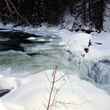

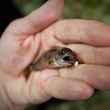




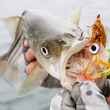




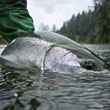




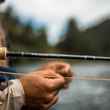



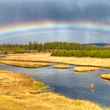
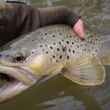


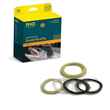

Comments